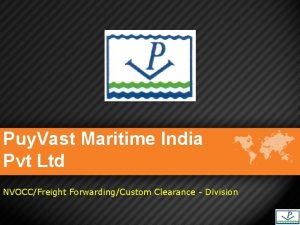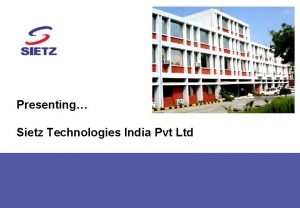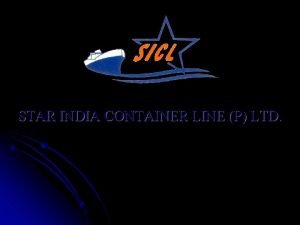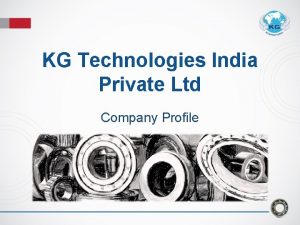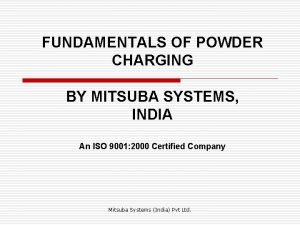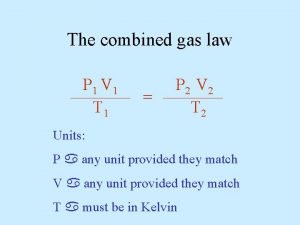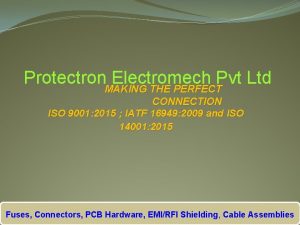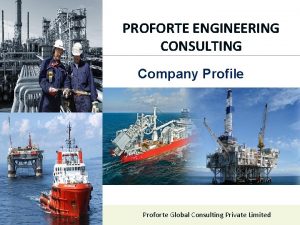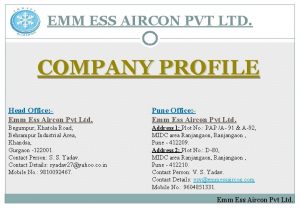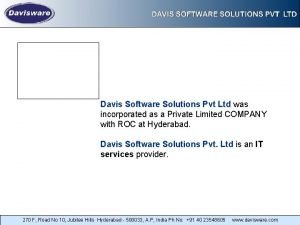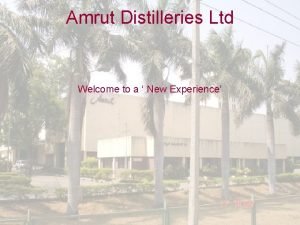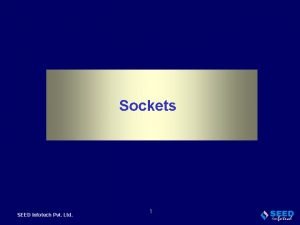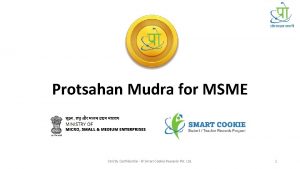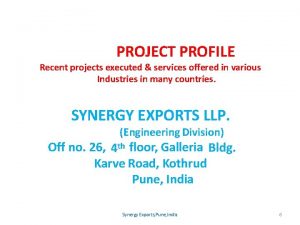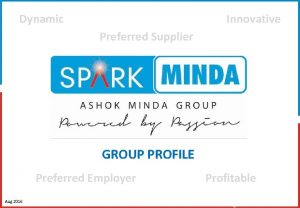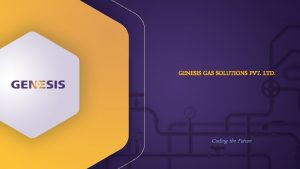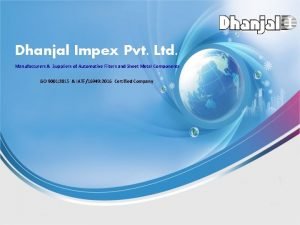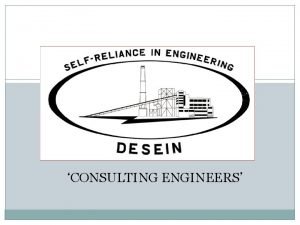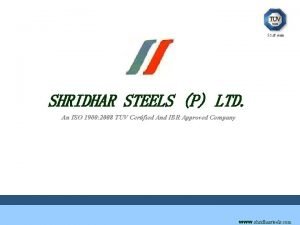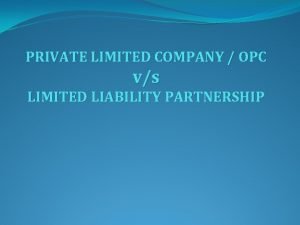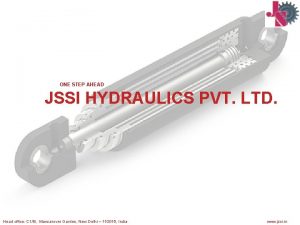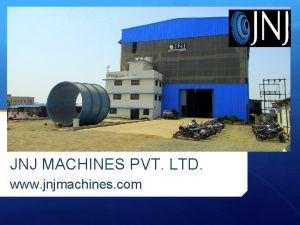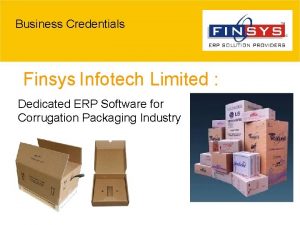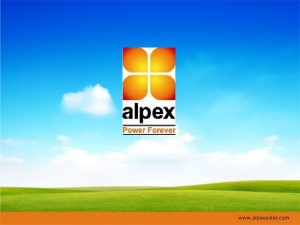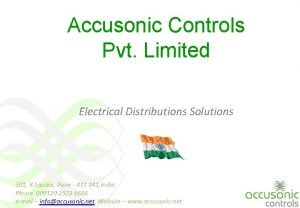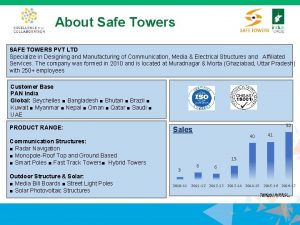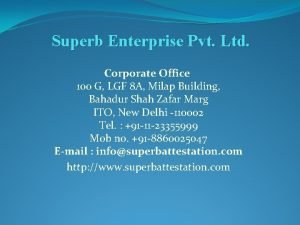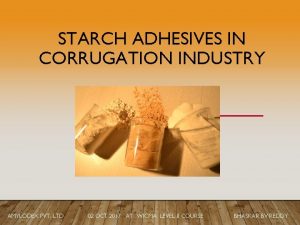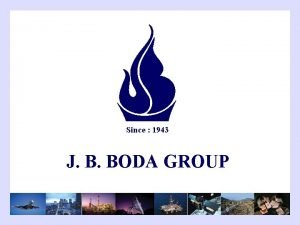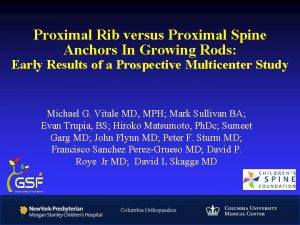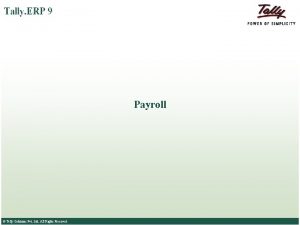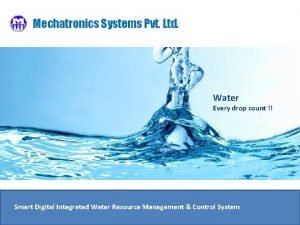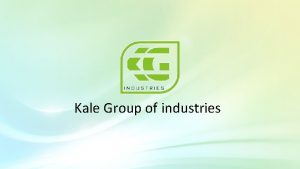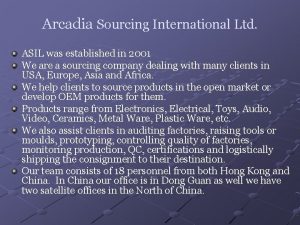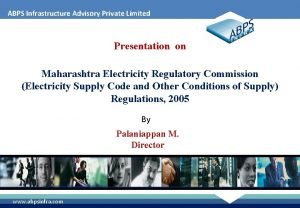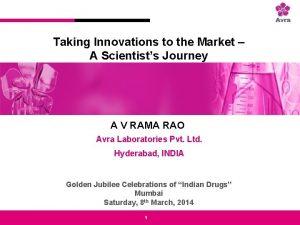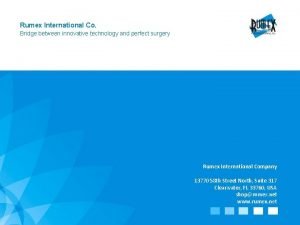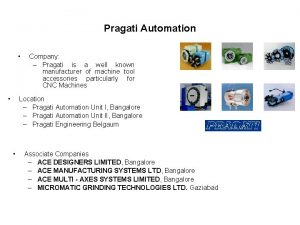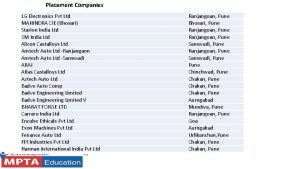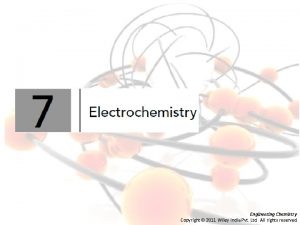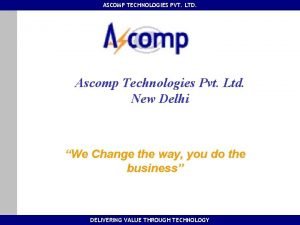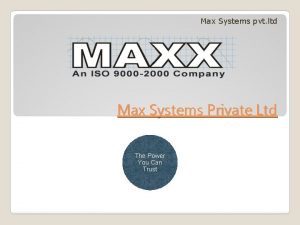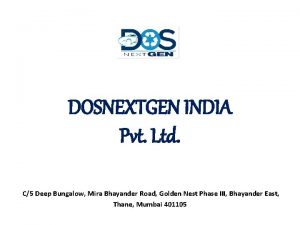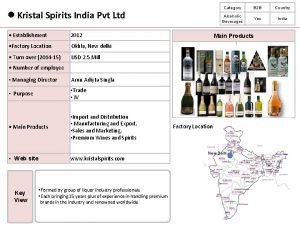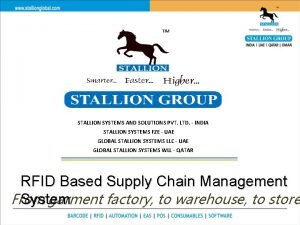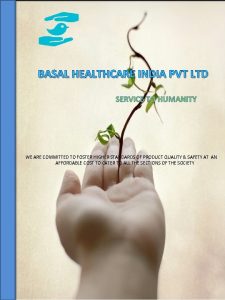Engineering Chemistry Copyright 2011 Wiley India Pvt Ltd

































![So soda required = 106(MW of soda)/ 100 [ 10 +2. 1] = 23. So soda required = 106(MW of soda)/ 100 [ 10 +2. 1] = 23.](https://slidetodoc.com/presentation_image_h/a04d237d7dd9a5c86943f1f0195d22f7/image-34.jpg)




























































- Slides: 94

Engineering Chemistry Copyright 2011 Wiley India Pvt. Ltd. All rights reserved.

Sources of Water Oceans and seas contain 96. 5% water, and snow and groundwater hold 1. 74% and 1. 7%, respectively. Impurities in Water Ø Biological impurities: Microorganisms Ø Suspended impurities: Organic matter Ø Colloidal impurities: Metal hydroxides, oil globules Ø Dissolved impurities: Dissolved gases and salts Engineering Chemistry Copyright 2011 Wiley India Pvt. Ltd. All rights reserved.

Hardness of water: Presence of Ca+2 and Mg+2 ions in water prevents the formation of lather with soap. To know “How hard water prevents the formation of lather with soap? ” First we have to know how soap work? Engineering Chemistry Copyright 2011 Wiley India Pvt. Ltd. All rights reserved.

How soap works? Soaps are sodium or potassium fatty acids (Palmitic acid Stearic acid Oleic acid) salts. Each soap molecule has a long hydrocarbon chain, sometimes called its 'tail', with a carboxylate 'head'. In water, the sodium or potassium ions float free, leaving a negatively-charged head. Na Salt of Stearic acid

The organic part of a natural soap is a negatively-charged, polar molecule. Its hydrophilic (water-loving) carboxylate group (-CO 2) interacts with water molecules via ion-dipole interactions and hydrogen bonding. The hydrophobic (water-fearing) part of a soap molecule, its long, nonpolar hydrocarbon chain, does not interact with water molecules. The hydrocarbon chains are attracted to each other by dispersion forces and cluster together, forming structures called micelles.

In hard water the Ca+2 and Mg+2 ions replaces the Na+ ion from fatty acid salt (in the soap) and make water insoluble fatty acid salt, thus prevent the formation of foam. From soap Water soluble From hard water Water insoluble

Types of Hardness Temporary hardness: due to presence of bicarbonates and carbonate of calcium and magnesium; can be Removed by boiling. Permanent hardness: due to presence of chlorides and sulphates of calcium and Magnesium; cannot be removed by boiling; removed by softening agents. Engineering Chemistry Copyright 2011 Wiley India Pvt. Ltd. All rights reserved.

Degree of hardness: Expressed in terms of Ca. CO 3 equivalent (in mg/l) In ppm or mg/l Degree Clarke ( 0 Cl) = It’s number of equivalent of Ca. CO 3 present in 70, 000 parts of water Degree Feench (0 F) = It’s number of equivalent of Ca. CO 3 present in 105 parts of water 1 ppm = 1 mg/l = 0. 10 F = 0. 070 Cl Engineering Chemistry Copyright 2011 Wiley India Pvt. Ltd. All rights reserved.

What is the temporary , permanent and total hardness of a 1 L of water sample containing 12. 2 mg of Ca(HCO 3)2 and 5. 6 mg of Mg. SO 4 ? Temporary hardness: = 7. 53 mg/l Permanent hardness: = 4. 67 mg/l Total hardness = Temporary hardness+ Permanent hardness = 7. 53 + 4. 67 = 12. 2 mg/l

Determination of Hardness of Water Soap Solution Method Hard water does not produce lather until all the ions causing hardness have precipitated. Complexometric Ttration Method: EDTA reacts with calcium and magnesium ions which cause hardness and forms complex compounds. Engineering Chemistry Copyright 2011 Wiley India Pvt. Ltd. All rights reserved.

Complexometric Ttration Method using EDTA: 1. When indicator is added to hard water it combines with free metal ions present in water. HIn-2 + M+2 → MIn- + H+ {M = Mg or Ca} (Wine red) When EDTA solution is added to the titration flask it combines with the free metal ions giving metal EDTA complex, which is stable and colorless. H 2 Y 2 - + M+2 → MY-2 + 2 H+ When all the free metal ions are exhausted, next drop of EDTA removes the metal ion engaged with indicator and the original blue color is restored. H 2 Y 2 - + MIn+ → MY-2 + HIn+2 + H+

Hardness calculation using EDTA -------(1) Normality of sample is calculated by titrating it against EDTA. By applying normality equation: Nsample × V sample = NEDTA × VEDTA …………………. (2) Substitute Eq. (2) in Eq. (1)

Hardness calculation using EDTA If molarity of EDTA solution is given

100 ml of water sample required 13. 5 ml of 0. 02 M EDTA. What is the total hardness?

Alkalinity of water Its ability of water to neutralize acid. Types of Alkalinity Ø carbon dioxide and bicarbonate Ø bicarbonate and carbonate Ø hydroxyl groups Alkalinity is estimated by titration of water with a standard acid solution using phenolphthalein and methyl orange as indicators.

General Considerations • Its capacity to neutralize acids or its buffering capacity. • 3 major classes of materials A. Bicarbonates, HCO 3 - - p. H 4. 0 ≤ p. H 8. 3 B. Carbonates, CO 3 - - >p. H 8. 3 < p. H 9. 6 C. Hydroxide, OH- - > p. H 9. 6

Method of Analysis q • • • Phenolphthalein Alkalinity Phenolphthalein indicator p. H 8. 3 endpoint of titration Indicates neutralization of hydoxide ions and half of the Carbonates q Total Alkalinity • Methyl Orange indicator • p. H 4. 5 endpoint of titration • Indicates neutralization of hydoxide ions, carbonate and bicarbonate

**It’s practically impossible for the OH- and HCO 3 - to exist together as they will react within to give CO 3 -2

Alkalinity calculation by titrating water sample against acid -------(1) Normality of sample is calculated by titrating it against Acid By applying normality equation: Nsample × V sample = NAcid × VAcid …………………. (2) Substitute Eq. (2) in Eq. (1)

Alkalinity Relationships

100 ml water sample required 25 ml of 0. 05 N acid for phenlopthaline end point and another 10 ml for methyl orange end point. Determine alkalinity. P = 25 ml M = 35 ml

Types of Hardness * Calcium and Magnesium Hardness * Total Hardness – Calcium Hardness = Magnesium Hardness * Carbonate and Noncarbonate Hardness • When alkalinity < Total Hardness, then CO 3 Hardness = T. Alkalinity • When alkalinity ≥ Total hardness, Then CO 3 Hardness = Total Hardness * CO 3 hardness removed by boiling or lime (Temporary Hardness) * Noncarbonate Hardness (permanent) = T. Hardness – CO 3 Hardness * Pseudo-Hardness * Associated with Na+ which causes soap consumption but not considered part of hardness.

Techniques for Water Softening External Treatment for Softening Water Ø Lime soda process Engineering Chemistry Copyright 2011 Wiley India Pvt. Ltd. All rights reserved.

Removal of Carbonate Hardness *** Ca. CO 3 is precipitated out of the water (sludge) and it’s filtered off. Removal of Noncarbonate Hardness Lime is used to remove temporary hardness + Mgpermanent hardness, Soda Ash is used mainly to remove permanent hardness.

Lime-Soda Softening method Batch Softening ( Lime and soda Continuous Softening ( Lime and soda Both are mixed together with hard water are added to hard water into different tank. After completing of reaction, the compartment. ) sludge is filtered off) Advantage: It not only reduce hardness but also reduce the TDS, alkalinity. Disadvantage: It cannot remove the water hardness completely.

Ion exchange process Harmful cations and anions are removed by harmless ions from ion exchange resin. Resins are high molecular weight cross linked polymer having acidic (-SO 3 HCOOH) or basic (substituted amion group) functional group attached with the polymer chain. Cationic Exchangers: - Strongly acidic – functional groups derived from strong acids e. g. , R-SO 3 H (sulfonic). Weakly acidic – functional groups derived from weak acids, e. g. , R-COOH (carboxylic). Anionic Exchangers: Strongly basic – functional groups derived from quaternary ammonia compounds, R-N-OH. Weakly basic - functional groups derived from primary and secondary amines, R-NH 3 OH or R-R’-NH 2 OH

Water is first passed through the cation exchange resin where Ca +2, Mg+2 is exchanged with H+ from the resin, then the water is passed through the anion exchange resin where Cl-, SO 4 -2 is exchanged with OHWater containing Ca. Cl 2 Water containing 2 HCl M-RCOOH+ + Ca. Cl 2 (M-RCOO)2 Ca + 2 HCl M-RN+(CH 3)3 OH- + 2 HCl (M-RN+(CH 3)3 Cl- + 2 H 2 O Water free of Ca. Cl 2 M-RN+(CH 3)3 OH-

Cation exchange Resin can be regenerated by passing dil H 2 SO 4 and HCL through it and anion exchange resin can be regenerated by passing NH 4 OH and Na. OH through it. Zeolite (Permutit) process Na 2 OAl 2 O 3, x. Si. O 2, y. H 2 O The Na+ ion from zeolite can be exchanged with the hardness causing cation from hard water.

Zeolite is naturally occuring hydrated aluminosilicate (Na 2 OAl 2 O 3, XSi. O 2, y. H 2 O) It is a process where hard water containing ions such as Ca+2, Mg+2 is filtered through either a natural sand called Zeolite or man made beads. In either case the Ca++ ions and other hard water metallic ions are caught as they bond to the zeolite or beads. As this happens, Na+ ions are realeased from the zeolite and flush on into the water supply. Then after the zeolite becomes saturated with hard water ions, it is "renewed" by flushing it with a rich solution of Na. Cl where the excess Na+ ions go in and replace the hard water ions, flush them down the drain during the recharging; cycles when the water softener is disconnected from the regular water supply. Recharging usually takes place at night when water is not needed.

Ø Zeolite (Permutit) process Zeolites are naturally occurring hydrated aluminosilicate minerals. Engineering Chemistry Copyright 2011 Wiley India Pvt. Ltd. All rights reserved.

Internal Treatment for Softening Water: (Carried out inside boiler) Ø Complexation Ø Calgon (Sodium Hexametaphosphate) Treatment Ø Carbonate Treatment Engineering Chemistry Copyright 2011 Wiley India Pvt. Ltd. All rights reserved.

Before solving numerical problems –take a look

Calculate the lime and soda required for softening 50, 000 l of water containing the following salts: Ca(HCO 3)2 = 8. 1 mg/l, Mg(HCO 3)2 = 7. 5 mg/l and Ca. SO 4 = 13. 6 mg/l, Mg. SO 4 = 12 mg/l, Mg. Cl 2 = 2 mg/l Ca(HCO 3)2 = 8. 1 mg/l = 8. 1 × 100/ 162 = 5 mg/ l Ca. CO 3. Mg(HCO 3)2 = 7. 5 mg/l = 7. 5 × 100/146 = 5. 13 mg/l of Ca. CO 3 Similarly Ca. SO 4= 10 mg/l, Mg. SO 4 = 10 mg/l, Mg. Cl 2 = 2. 1 mg/l of Ca. CO 3 equivalent. So lime required = 74 (MW of Lime)/ 100 (MW of Ca. CO 3)[5+2× 5. 13 +10 + 2. 1] = 20. 25 mg/l.
![So soda required 106MW of soda 100 10 2 1 23 So soda required = 106(MW of soda)/ 100 [ 10 +2. 1] = 23.](https://slidetodoc.com/presentation_image_h/a04d237d7dd9a5c86943f1f0195d22f7/image-34.jpg)
So soda required = 106(MW of soda)/ 100 [ 10 +2. 1] = 23. 43 mg/l Now calculate it for 50, 000 L.

Reverse Osmosis Process Water flows from High conc. of water To low conc. of water

It results in conc. Of all solutes In one compartment and all pure Water in another compartment








Chlorination Water chlorination is the process of adding the element chlorine to water as a method of water purification to make it for human consumption as drinking water. Water that has been treated with chlorine is effective in preventing the spread of waterborne disease. chlorine is a highly efficient disinfectant, and is added to public water supplies to kill disease-causing pathogens, such as bacteria, viruses and protozoans The chlorination process involves adding chlorine to water, but the chlorinating product does not necessarily have to be pure chlorine. Chlorination can also be carried out using chlorine-containing substances. Depending on the p. H conditions required and the available storage options, different chlorine-containing substances can be used. The three most common types of chlorine used in water treatment are: chlorine gas, sodium hypochlorite, and calcium hypochlorite.

Cl 2 + H 2 O HOCl + H+ + OCl- How does chlorine disinfection work? Chlorine kills pathogens such as bacteria and viruses by breaking the chemical bonds in their molecules. Disinfectants that are used for this purpose consist of chlorine compounds which can exchange atoms with other compounds, such as enzymes in bacteria and other cells. When enzymes come in contact with chlorine, one or more of the hydrogen atoms in the molecule are replaced by chlorine. This causes the entire molecule to change shape or fall apart. When enzymes do not function properly, a cell or bacterium will die. OCl- = Cl- + O This O is also disinfectant.

HOCl, which is electrically neutral and hypochlorite ions (OCl-, electrically negative) will form free chlorine when bound together. This results in disinfection. Both substances have very distinctive behaviour. HOCl acid is more reactive and is a stronger disinfectant than hypochlorite. HOCl acid is split into hydrochloric acid (HCl) and oxygen (O). The oxygen atom is a powerful disinfectant. The disinfecting properties of chlorine in water are based on the oxidising power of the free oxygen atoms and on chlorine substitution reactions.

Water Drainage • Drainage means the removal of excess water from a given place. • Two types of drainage can be identified: • i) Land Drainage: This is large scale drainage where the objective is to drain surplus water from a large area by such means as excavating large open drains, and levees and pumping. Such schemes are necessary in low lying areas and are mainly Civil Engineering work.

ii) Field Drainage: • This is the drainage that concerns us in agriculture. It is the removal of excess water from the root zone of crops. •


Water in Soil After Heavy Rain

The main aims of Field drainage include: • i) To bring soil moisture down from saturation to field capacity. At field capacity, air is available to the soil and most soils are mesophites ie. like to grow at moisture less than saturation. • ii) Drainage helps improve hydraulic conductivity: Soil structure can collapse under very wet conditions and so also engineering structures. • iii) In some areas with salt disposition, especially in arid regions, drainage is used to leach excess salt.

The main aims of Field drainage Contd. • iv) In irrigated areas, drainage is needed due to poor application efficiency which means that a lot of water is applied. • v) Drainage can shorten the number of occasions when cultivation is held up waiting for soil to dry out.

Two types of drainage exist: Surface and Sub-surface drainage. • 4. 2 DESIGN OF SURFACE DRAINAGE SYSTEMS: • Surface drainage involves the removal of excess water from the surface of the soil. • This is done by removing low spots where water accumulates by land forming or by excavating ditches or a combination of the two.

Surface Drainage

DESIGN OF SUB-SURFACE DRAINAGE SYSTEMS • Sub-surface drainage is the removal of excess groundwater below the soil surface. • It aims at increasing the rate at which water will drain from the soil, and so lowering the water table, thus increasing the depth of drier soil above the water table. • Sub-surface drainage can be done by open ditches or buried drains.

Sub-Surface Drainage Using Ditches















Sewage Treatment • Secondary Treatment (Microbial Process) – Supernatant or primary effluent contains high levels of dissolved organic load (Biological Oxygen Demand) – Aeration to stimulate aerobic degradation • activated sludge reactor • trickling filter reactor bacteria degrade organic carbon to CO 2


trickling filter

Activated sludge • mixed community of microorganisms • Both aerobic and anaerobic bacteria may exist The water is mixed with biological agents and then aerated. The increased oxygen promotes the growth of the beneficial biological material. That material will consume unwanted waste products held in the water. Finally, the beneficial material will grow due to the increased oxygen and food, which makes it easier to filter from the clean water.


Treatment stages – Tertiary treatment • remove disease-causing organisms from wastewater • 3 different disinfection process – Chlorination – UV light radiation – Ozonation

Chlorination • Most common • Advantages: low cost & effective • Disadvantages: chlorine residue could be harmful to environment

UV light radiation • Damage the genetic structure of bacteria, viruses and other pathogens. • Advantages: no chemicals are used • water taste more natural • Disadvantages: high maintenance of the UVlamp

Ozonation • Oxidized most pathogenic microorganisms • Advantages: safer than chlorination fewer disinfection by-product • Disadvantage: high cost

Analysis of Water Determination of various ions is carried out as follows: Ø Chloride by argentometric method Ø Fluoride by SPADNS method Ø Nitrate by phenol disulphonic method Ø Sulphate by gravimetric method Ø Dissolved oxygen by Winkler’s method Engineering Chemistry Copyright 2011 Wiley India Pvt. Ltd. All rights reserved.

Disadvantages of Hard Water Hard water is neither fit for domestic purposes nor for industrial purposes. Domestic Purposes 1. Laundering 2. Bathing 3. Dishwashing Industrial Purposes 1. Sugar industry 2. Concrete industry 3. Pharmaceutical industry 4. Textile industry 5. Dyeing industry 6. Water boilers and pipes Engineering Chemistry Copyright 2011 Wiley India Pvt. Ltd. All rights reserved.

Potable Water is made fit for domestic use by the following treatments: Ø Pretreatment Ø Removal of suspended impurities by: Screening Flocculation Sedimentation Filtration Engineering Chemistry Copyright 2011 Wiley India Pvt. Ltd. All rights reserved.

Disinfection of Water • Physical methods: UV light, gamma radiation • Chemical methods: chlorine, chlorine dioxide, hypochlorite, ozone, hydrogen peroxide, potassium permanganate, halogens 1. Chlorination 2. Ozonization Engineering Chemistry Copyright 2011 Wiley India Pvt. Ltd. All rights reserved.

Desalination of Brackish Water Reverse Osmosis Engineering Chemistry Copyright 2011 Wiley India Pvt. Ltd. All rights reserved.

Electrodialysis Engineering Chemistry Copyright 2011 Wiley India Pvt. Ltd. All rights reserved.

Multi-stage Flash Distillation. Engineering Chemistry Copyright 2011 Wiley India Pvt. Ltd. All rights reserved.

Boiler Feed Water Should be such that the impurities can be concentrated a reasonable number of times without exceeding the tolerance limits. Boiler Troubles/Problems Ø Scale (hard deposits) and sludge (suspended solids) formation Engineering Chemistry Copyright 2011 Wiley India Pvt. Ltd. All rights reserved.

Ø Priming (outlet steam containing large drops of water) and Foaming (bubble formation on surface of boiler water) Ø Caustic Embrittlement (material becomes brittle due to exposure to caustic solutions at high temperature and pressure) Ø Boiler Corrosion (degradation of boiler surface by feed water containing dissolved oxygen and carbon dioxide) Engineering Chemistry Copyright 2011 Wiley India Pvt. Ltd. All rights reserved.

Ø Ion exchange process (demineralization) Engineering Chemistry Copyright 2011 Wiley India Pvt. Ltd. All rights reserved.

Sewage Characteristics of waste water: 1. Biological oxygen demand (BOD): amount of dissolved oxygen needed by aerobic microorganisms in a water body to breakdown organic matter. 2. Chemical oxygen demand (COD): amount of oxygen consumed to oxidize organic and oxidizable inorganic material. Engineering Chemistry Copyright 2011 Wiley India Pvt. Ltd. All rights reserved.

Sewage treatment Engineering Chemistry Copyright 2011 Wiley India Pvt. Ltd. All rights reserved.

Primary Waste Treatment Filter through screens and sedimentation Secondary Waste Treatment 1. Trickling Filter Engineering Chemistry Copyright 2011 Wiley India Pvt. Ltd. All rights reserved.

2. 3. Rotating biological reactor Activated sludge process Engineering Chemistry Copyright 2011 Wiley India Pvt. Ltd. All rights reserved.

Tertiary Waste Treatment Sand filter/ Activated carbon filter Lagoons Denitrification Disinfection Engineering Chemistry Copyright 2011 Wiley India Pvt. Ltd. All rights reserved.
 Spine technologies (i) pvt. ltd
Spine technologies (i) pvt. ltd Puyvast maritime india pvt ltd
Puyvast maritime india pvt ltd Dialight obstruction light
Dialight obstruction light Sietz technologies india pvt. ltd.
Sietz technologies india pvt. ltd. Posiflex technology (india) pvt. ltd.
Posiflex technology (india) pvt. ltd. Manas geo tech
Manas geo tech Star india container line pvt.ltd.
Star india container line pvt.ltd. Kedar gupta dubai
Kedar gupta dubai Hd motor company india pvt ltd
Hd motor company india pvt ltd Avgol india pvt ltd
Avgol india pvt ltd Infodrive india pvt ltd kalkaji
Infodrive india pvt ltd kalkaji Dotcom services india pvt ltd
Dotcom services india pvt ltd Humboldt wedag india pvt ltd delhi
Humboldt wedag india pvt ltd delhi Mitsuba systems
Mitsuba systems Pv/t = pv/t units
Pv/t = pv/t units Tesca electrical
Tesca electrical Suttind seeds pvt ltd
Suttind seeds pvt ltd Savex technologies pvt ltd bhiwandi
Savex technologies pvt ltd bhiwandi Aarambh revolution pvt ltd
Aarambh revolution pvt ltd Shailja tex prints pvt ltd
Shailja tex prints pvt ltd Protectron electromech (p) ltd
Protectron electromech (p) ltd Proforte
Proforte Prevail casting
Prevail casting Margy tech pvt ltd
Margy tech pvt ltd Raksha health insurance tpa
Raksha health insurance tpa Max systems pvt ltd
Max systems pvt ltd Kapgrow corporate advisory services pvt. ltd
Kapgrow corporate advisory services pvt. ltd Jagruti technical services pvt ltd
Jagruti technical services pvt ltd Emm ess aircon pvt ltd
Emm ess aircon pvt ltd Dss systems and software technologies pvt. ltd.
Dss systems and software technologies pvt. ltd. Davisware
Davisware Arun zurel
Arun zurel Bl lifesciences
Bl lifesciences Avi solar energy pvt ltd
Avi solar energy pvt ltd Ascon infratech pvt ltd
Ascon infratech pvt ltd Amrut distilleries pvt ltd
Amrut distilleries pvt ltd U74999
U74999 Arete consultants pvt ltd
Arete consultants pvt ltd Triz innovation pvt ltd
Triz innovation pvt ltd Margy tech pvt ltd
Margy tech pvt ltd Gaf global logistics pvt ltd
Gaf global logistics pvt ltd Tvs industrial & logistics parks pvt ltd
Tvs industrial & logistics parks pvt ltd Inet infotech pvt ltd
Inet infotech pvt ltd Tipl tally solutions
Tipl tally solutions Smartcookie aicte
Smartcookie aicte Protech consultants pvt ltd
Protech consultants pvt ltd Everest solvent pvt ltd nepal
Everest solvent pvt ltd nepal Maven vista technologies pvt ltd
Maven vista technologies pvt ltd Jagruti technical services pvt ltd
Jagruti technical services pvt ltd Minda vast access systems pvt. ltd
Minda vast access systems pvt. ltd Th30720
Th30720 Wifi-soft solutions pvt ltd
Wifi-soft solutions pvt ltd Genesis gas solutions
Genesis gas solutions Dhanjal impex pvt. ltd
Dhanjal impex pvt. ltd Desein pvt ltd
Desein pvt ltd Column software technologies pvt ltd
Column software technologies pvt ltd Alexis global private limited
Alexis global private limited Agm auto pvt ltd
Agm auto pvt ltd Iso 1900
Iso 1900 Seagull shipping & logistic (pvt) ltd
Seagull shipping & logistic (pvt) ltd Art sign (pvt.) ltd
Art sign (pvt.) ltd Biz worldwide (pvt) ltd
Biz worldwide (pvt) ltd Opc vs pvt ltd
Opc vs pvt ltd Jssi hydraulics pvt. ltd
Jssi hydraulics pvt. ltd Syft
Syft Jnj machines pvt ltd
Jnj machines pvt ltd Indivirtus healthcare services pvt ltd
Indivirtus healthcare services pvt ltd Datacore technologies pvt ltd
Datacore technologies pvt ltd Dee kay buildcon pvt ltd
Dee kay buildcon pvt ltd Finsys infotech pvt ltd
Finsys infotech pvt ltd Tesca resco
Tesca resco Accusonic controls pvt ltd
Accusonic controls pvt ltd Safe towers private limited ghaziabad
Safe towers private limited ghaziabad Bimal pharma pvt ltd
Bimal pharma pvt ltd Jsn infotech pvt ltd
Jsn infotech pvt ltd M/s superb enterprises pvt. ltd
M/s superb enterprises pvt. ltd Amylodex
Amylodex J.b. boda net worth
J.b. boda net worth Ravel fire alarm panel
Ravel fire alarm panel Rib group pvt ltd
Rib group pvt ltd Payroll in tally
Payroll in tally Mechatronics systems private limited
Mechatronics systems private limited Abans finance pvt ltd
Abans finance pvt ltd Kale group of industries
Kale group of industries Feathers management services pvt ltd
Feathers management services pvt ltd Cozy infosystems pvt ltd
Cozy infosystems pvt ltd Arcadian sourcing (pvt) ltd
Arcadian sourcing (pvt) ltd Abps infrastructure advisory pvt ltd
Abps infrastructure advisory pvt ltd Advanced facility management services
Advanced facility management services Swan environmental pvt ltd
Swan environmental pvt ltd Strictly private & confidential
Strictly private & confidential Rumex international pvt ltd
Rumex international pvt ltd Pragati automation
Pragati automation Varsa plastic industries pvt ltd baramati
Varsa plastic industries pvt ltd baramati Pe systems pvt ltd
Pe systems pvt ltd

